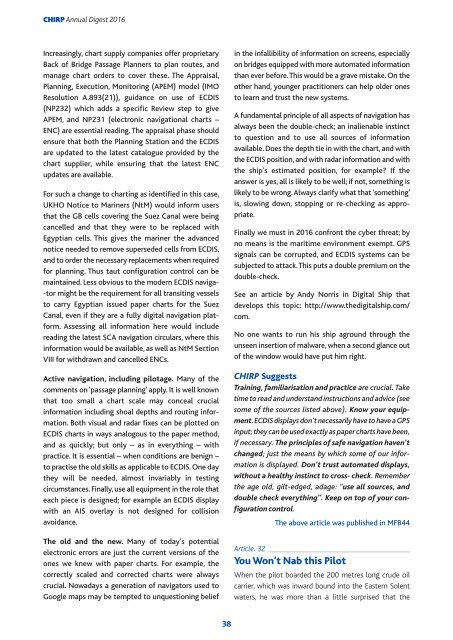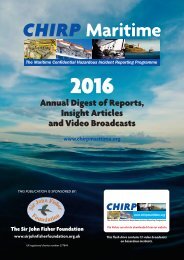CHIRP annual digest 2016 6th
Create successful ePaper yourself
Turn your PDF publications into a flip-book with our unique Google optimized e-Paper software.
<strong>CHIRP</strong> Annual Digest <strong>2016</strong><br />
Increasingly, chart supply companies offer proprietary<br />
Back of Bridge Passage Planners to plan routes, and<br />
manage chart orders to cover these. The Appraisal,<br />
Planning, Execution, Monitoring (APEM) model (IMO<br />
Resolution A.893(21)), guidance on use of ECDIS<br />
(NP232) which adds a specific Review step to give<br />
APEM, and NP231 (electronic navigational charts –<br />
ENC) are essential reading. The appraisal phase should<br />
ensure that both the Planning Station and the ECDIS<br />
are updated to the latest catalogue provided by the<br />
chart supplier, while ensuring that the latest ENC<br />
updates are available.<br />
For such a change to charting as identified in this case,<br />
UKHO Notice to Mariners (NtM) would inform users<br />
that the GB cells covering the Suez Canal were being<br />
cancelled and that they were to be replaced with<br />
Egyptian cells. This gives the mariner the advanced<br />
notice needed to remove superseded cells from ECDIS,<br />
and to order the necessary replacements when required<br />
for planning. Thus taut configuration control can be<br />
maintained. Less obvious to the modern ECDIS naviga -<br />
-tor might be the requirement for all transiting vessels<br />
to carry Egyptian issued paper charts for the Suez<br />
Canal, even if they are a fully digital navigation plat -<br />
form. Assessing all information here would include<br />
reading the latest SCA navigation circulars, where this<br />
information would be available, as well as NtM Section<br />
VIII for withdrawn and cancelled ENCs.<br />
Active navigation, including pilotage. Many of the<br />
comments on ‘passage planning’ apply. It is well known<br />
that too small a chart scale may conceal crucial<br />
information including shoal depths and routing infor -<br />
mation. Both visual and radar fixes can be plotted on<br />
ECDIS charts in ways analogous to the paper method,<br />
and as quickly; but only – as in everything – with<br />
practice. It is essential – when conditions are benign –<br />
to practise the old skills as applicable to ECDIS. One day<br />
they will be needed, almost invariably in testing<br />
circumstances. Finally, use all equipment in the role that<br />
each piece is designed; for example an ECDIS display<br />
with an AIS overlay is not designed for collision<br />
avoidance.<br />
The old and the new. Many of today’s potential<br />
electronic errors are just the current versions of the<br />
ones we knew with paper charts. For example, the<br />
correctly scaled and corrected charts were always<br />
crucial. Nowadays a generation of navigators used to<br />
Google maps may be tempted to unquestioning belief<br />
in the infallibility of information on screens, especially<br />
on bridges equipped with more automated information<br />
than ever before. This would be a grave mistake. On the<br />
other hand, younger practitioners can help older ones<br />
to learn and trust the new systems.<br />
A fundamental principle of all aspects of navigation has<br />
always been the double-check; an inalienable instinct<br />
to question and to use all sources of information<br />
available. Does the depth tie in with the chart, and with<br />
the ECDIS position, and with radar information and with<br />
the ship’s estimated position, for example? If the<br />
answer is yes, all is likely to be well; if not, something is<br />
likely to be wrong. Always clarify what that ‘something’<br />
is, slowing down, stopping or re-checking as appro -<br />
priate.<br />
Finally we must in <strong>2016</strong> confront the cyber threat; by<br />
no means is the maritime environment exempt. GPS<br />
signals can be corrupted, and ECDIS systems can be<br />
subjected to attack. This puts a double premium on the<br />
double-check.<br />
See an article by Andy Norris in Digital Ship that<br />
develops this topic: http://www.thedigitalship.com/<br />
com.<br />
No one wants to run his ship aground through the<br />
unseen insertion of malware, when a second glance out<br />
of the window would have put him right.<br />
<strong>CHIRP</strong> Suggests<br />
Training, familiarisation and practice are crucial. Take<br />
time to read and understand instructions and advice (see<br />
some of the sources listed above). Know your equip -<br />
ment. ECDIS displays don’t necessarily have to have a GPS<br />
input; they can be used exactly as paper charts have been,<br />
if necessary. The principles of safe navigation haven’t<br />
changed; just the means by which some of our infor -<br />
mation is displayed. Don’t trust automated displays,<br />
without a healthy instinct to cross- check. Remember<br />
the age old, gilt-edged, adage: “use all sources, and<br />
double check everything”. Keep on top of your con -<br />
figuration control.<br />
The above article was published in MFB44<br />
Article. 32<br />
You Won’t Nab this Pilot<br />
When the pilot boarded the 200 metres long crude oil<br />
carrier, which was inward bound into the Eastern Solent<br />
waters, he was more than a little surprised that the<br />
38



